If you’re currently struggling with period pain that knocks you back for a day (or more), or have to use painkillers to get you through that time of the month, you might be wishing your period could just go away altogether. I know it might not seem like it, but having a monthly period is a tool you can use to improve your health. Period pains can be a sign that something could be off balance, and there is a way to reduce period pains naturally.
Why are we told period pain is normal?
Here’s the thing. As women, we’re not taught enough about our menstrual cycles and hormones. I vaguely remember having a 1-hour lesson in school about periods, and then they were never spoken about again, the rest I had to learn myself. Painful periods are so common that we’re told they’re normal. But are we meant to be stuck in bed, curled over in pain every. single. month?
Short answer – no we’re not.
But no one tells you that! They tell you it’s what you have to accept as being a woman. Because we’re made to believe that being in excruciating pain each month is normal, we’re not aware of how we can reduce period pain naturally. And by the way, if you’re period pains are that bad they need to be investigated because it could be a sign of hormonal conditions such as Endometriosis, Polycystic Ovarian Syndrome, or Fibroids. Be sure to push your doctor for investigations (like hormone tests & scans!) before being handed out the pill as a miracle cure and sent on your way.
Okay, so how can my period be a tool to improve my health?
Well, each month your period and menstrual cycle is like a report card. The PMS symptoms that are so often labelled as normal, can actually be signs of hormonal imbalances. So if each month you’re getting really bad period pain, we need to look into what could be causing it, and how we can reduce period pain (because you can!). A good place to start here would be to understand why we get period pains in the first place.
What causes period pains?
Every month, our hormones work to prep our bodies for pregnancy. In the first half of the cycle, oestrogen rises to encourage the thickening of the uterine lining. Progesterone also plays a role in preparing the uterine lining for pregnancy, and its levels will increase after ovulation. If we don’t become pregnant, hormone levels drop which triggers the body to shed the uterine lining = you have a period.
So you know why you have a period, but why do you have pain with it?
The reason we get period pains is due to hormone-like substances called prostaglandins. These encourage the muscles in the uterus to contract, which causes the uterine lining to shed effectively. They can be triggered by inflammation or tissue damage, where they can cause inflammation and pain. Now, this is actually a healthy response. We need a healthy amount of inflammation for our body to function correctly and heal. But when we have higher than normal levels of inflammation and prostaglandins, we get more severe period pain!
Now when it comes to period pains, a small amount of cramping is normal. But when it becomes so painful that you need painkillers and a day (or two) in bed, that isn’t. It’s a sign that you may have increased inflammation.
How to reduce period pains naturally
First – let’s look at how prostaglandins are made. They are produced from an omega-6 fatty acid known as arachidonic acid, and the production of prostaglandins can be increased by oestrogen, inflammation and insulin. So, we have four factors that might be causing increased period pains here.
- High levels of omega-6 intake
- Oestrogen imbalances
- Increased inflammation
- Blood glucose imbalances
This is actually good news. Because we can work on all of these through diet and lifestyle!
Balancing Omega-6 & Omega-3
Both omega-6 and omega-3 are essential fatty acids. They’re essential because if we don’t eat them, we will be deficient in them and this can affect everything from our mood to our immune system. But, we need to have a healthy balance of omega-6 to omega-3. In an ideal world, our omega-6 to omega-3 ratio should be roughly 4:1 or lower – the best would be 1:1. Unfortunately, due to the prevalence of processed and fast foods in modern diets, the typical ratio can range from 10:1 to 25:1 or even higher. Higher levels of omega-6 can increase inflammation and arachidonic acid levels = increased period pain! Omega-6 isn’t bad (it often gets a label that it is), we just need a healthy balance. Because omega-6 is more prevalent in our diets, we need to prioritise increasing omega-3 food sources.
Omega-3 rich foods include:
- Oily fish (salmon, mackerel, trout, herring, kippers, anchovies, sardines)
- Walnuts
- Flaxseeds & flaxseed oil
- Chia seeds
- Olives & olive oil
- Avocados & avocado oil
Balancing oestrogen
Having higher levels of oestrogen can start to promote inflammation. Oestrogen is essential to female health, so we don’t want to get rid of it, we just need to balance it. This means helping the body naturally clear out any excess, or used oestrogen, and detoxing it into its protective forms. We can do this through increasing cruciferous vegetables in our diets. These vegetables naturally contain the compounds indole-3-carbinol and diindolylmethane (DIM) which help to regulate oestrogen levels and detoxification.
Try to aim for 3-4 portions of cruciferous vegetables per week. You can choose from:
- Broccoli
- Cauliflower
- Turnips
- Rocket
- Kale
- Brussel sprouts
- Watercress
- Radish
- Kohlrabi
- Cabbage
Reducing inflammation
Now while inflammation is an essential part of health within our bodies, chronic, increased inflammation is not. Although not a perfect analogue, for now, imagine inflammation as a fire burning in your body.
But just like a fire needs fuel to start and continue to burn, inflammation in our body also has its fuel sources. Chronic infections, blood glucose imbalances, oestrogen dominance (increased oestrogen levels), toxins, stress, microbiome imbalances and a poor diet can all act as the fuel for this fire.
To reduce the inflammation, it’s crucial to identify and address the fuel sources and put the fire out from there. However, some foods help to reduce inflammation. Some include:
- Turmeric
- Ginger
- Green tea
- Rosemary
- Oily fish
Balancing blood glucose levels
If you’ve read a few of my blogs, you’ll know that blood sugar balance is mentioned in basically all of them. That’s how important it is! But to link it back to period pains, high levels of insulin can increase an enzyme called aromatase, which converts androgens into oestrogen, which can cause higher levels of oestrogen. Blood glucose imbalances can also contribute to inflammation, and the combination of high glucose and insulin, alongside increased oestrogen = increased prostaglandins = increased period pains!
To balance blood glucose levels, the best thing to do is avoid eating carbohydrate foods on their own. If we add protein, healthy fats or fibre to carbohydrates, we help to slow the absorption of glucose, which keeps our blood sugar stable.
Can supplements reduce period pains?
In my clinic, I will use targeted, high-dose supplements to help reduce period pain. But we have to find out what could be causing it first. We can find out the cause of period pain through a comprehensive blood test, alongside an in-depth consultation. If you’re currently struggling with severe period pain, please know that there is something you can do to help reduce period pain naturally – starting with the recommendations on this blog.
And if you need more help, I’m just an email away!





0 Comments